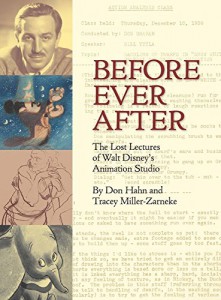 When you read about the history of the Walt Disney Animation Studio, it is briefly mentioned how Walt Disney started a training program for his animators. It’s always a quick couple of paragraphs during which a group of gag men suddenly become artists, leaping from Mickey making music on a cow’s udders to The Old Mill and ultimately the visual sophistication of Snow Whit and the Seven Dwarfs. Boom! Easy as pie… or not, as Before Ever After reveals.
When you read about the history of the Walt Disney Animation Studio, it is briefly mentioned how Walt Disney started a training program for his animators. It’s always a quick couple of paragraphs during which a group of gag men suddenly become artists, leaping from Mickey making music on a cow’s udders to The Old Mill and ultimately the visual sophistication of Snow Whit and the Seven Dwarfs. Boom! Easy as pie… or not, as Before Ever After reveals.
Animation producer Don Hahn and Tracey Miller-Zarneke have published the full story for the first time. Readers become a fly-on-the-wall at the Hyperion Studio as Walt Disney partners with Nelbert Chouinard of the Chouinard School of Art to have his team of animators attend night classes, often for little-to-no-money. Discover how Art Babbitt continued their training with live model session in his home, which eventually migrated back to the studio. Meet Don Graham, a Chouinard professor who became a teacher at Disney, routinely sitting with Walt in sweat box sessions to determine the next curriculum that was needed to elevate the quality of the artistic output. A practically forgotten name in this book is George Drake, who worked with Graham to recruit new talent in New York City and helped transition them to the studio in Burbank as production ramped up on Snow White.
If you’re a Disney history buff, this is all extremely exciting to read. But wait, there’s more! Transcripts of lecture’s and meetings with some of these key players in Disney’s early years have survived. They aren’t just presented here in text, but are presented as actual scans of the original typed sepia copies. You don’t just read about these people, you learn from them directly even though time has separated you from them by nearly seven decades.
Once the ground work is laid out, Before Ever After shifts its focus to “The Early Masters,” the seasoned and tremendously talented artists that were so giving of their time to newcomers to help improve their skills. Lectures are offered from some of the greatest animators of this era, such as Mickey Mouse’s main animator Les Clark, Snow White’s animator Ham Luske, musical genius Wilfred Jackson, and the man responsible for Mickey’s modern look, Fred Moore. In this section, you learn first hand from some of the greatest animators at the dawning of the medium.
Art wasn’t the only topic of lectures given at the studio. Don Graham saw the value of providing the Disney artists with a well rounded education in their field. “The Experts” is a collection of lectures from visitors to the studio who weren’t artists per se. Among them are early film professor Boris Morkovin, color theorist Faber Birren, and animal anatomy expert Rico Lebrun. The most interesting lecture in this section come from art critic Robert Feild, whose study of Disney lead him to publish The Art of Walt Disney in 1942. The only artist in this section is Jean Charlot, whose lecture offers an analysis of some famous works of art, which are presented in this book for reference.
In “A Trip to the Old World,” we learn about Walt’s 1935 tour of Europe, during which he recruited several talented European artists. It briefly mentions Gustaff Tenggren and Heinrich Kley, but it’s Oskar Fischinger, who claimed to have had the original idea for a “concert feature,” that really stands out. “The Parade of Visitors” is another section that chronicles the visiting talents that were naturally attracted to the Disney Studio and features some lectures they gave on their visits. Lectures from Frank Lloyd Wright, Alexander Woollcott and Roland Young can be found in this chapter.
Before wrapping things up, there is a section on the innovative achievements the Disney Studio made in these early years from before Steamboat Willie through the 1940’s. It gives credit where credit is due and highlights not only the obvious ones, but some of the less glamorous thinks like an in-house paint lab and a creative campus. The final chapter, “Ever After,” highlights how the artist strike and World War II forever changed the culture at the Disney Studio. It finishes the story of Walt’s relationship with the Chouinard Art Institute which eventually became CalArts.
Before Ever After is a master class textbook in animation. Many of the lessons found within regarding character study and elevated artistry still apply today. It’s amazing as a Disney fan to take a peak into the way it all began and the book beautifully sums up how as animators train younger generations, they’ve passed along these lessons. They’re still at play today on recent films like Frozen and the upcoming Zootopia. It’s a great way to link the past to the present. I highly recommend Before Ever After to Disney history buffs and animation fans alike.
